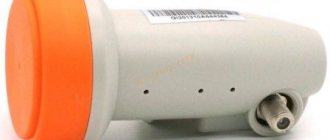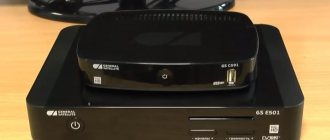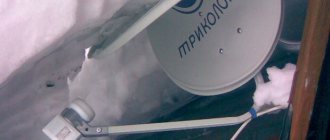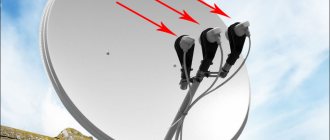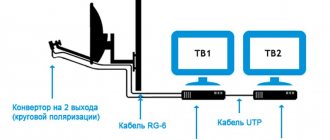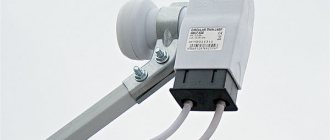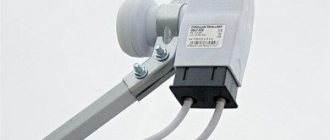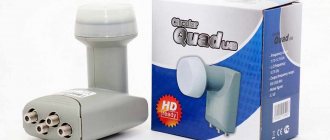Hello dear readers of the site. Today, satellite television and the Internet are gaining momentum due to their low cost, ease of installation, configuration and quality of reception. Satellite reception is especially used by people remote from big cities, where a satellite dish is the only link with the mainland.
And then one fine moment you turn on the TV, and they kindly answer you: “no signal.” A familiar situation, isn't it?
I will tell you how, without having the skills and knowledge in satellite broadcasting, you can find and, if possible, eliminate malfunctions of this nature.
How to check an antenna with a tester (multimeter)
First of all, you should pay attention to the TV cable. It should be intact and without any crimps.
- If this is a multi-story building, then you will only have to check the functionality of one end of the cable (with a plug). For this, a multimeter (tester) is used to measure the resistance between the braid and the central core of the wire. A value of several tens of ohms is considered a normal value. If it is greater than or close to “0”, a break or short circuit has occurred. In this case, it is better to find out whether the neighbors have a signal and, if so, then the problem is in the junction box or in the area from it to the plug.
- If this is a private home, then you can check the resistance of both ends of the TV cable. First you need to unplug all equipment from the outlet. Then disconnect the wire from the antenna and from the TV. And in the same way, use a tester to check the braiding and the central core for short circuits. Here, the serviceability of the cable is indicated by an infinite resistance value. But, if you short-circuit the central core and braid, the multimeter should show a value close to “0”.
When the device detects a malfunction, it is necessary, first, to find the weak point of the cable. This usually occurs in places where there are sharp bends, connected sections, or where the wind sways. If everything is fine with the TV cable, the cause of the problem should be looked for elsewhere.
Selecting a convector
Externally, the converter is a small device in a metal casing. It, in turn, is embedded in an L-shaped plastic case. Although all devices appear similar in appearance, they have differences.
When choosing a suitable convector, you need to pay special attention to the following points:
- Noise background. It should usually be within 0.3-0.5 dB. Most devices on the market meet this parameter.
- Polarization. It can be linear (designation – Universal) or circular (Circular). Tricolor polarization is circular and it makes no sense for subscribers to purchase devices labeled Universal.
- Number of connectors. Typically, devices with 2 outputs are used for Tricolor. But there are also convectors with 1, 4, 8 connectors. Their number determines how many receivers can be connected. Theoretically, you can split the signal already in the house using a splitter, but in this case its quality will decrease, problems will arise with the image quality on HD channels, and some TV channels may even refuse to show.
The company advises purchasing equipment exclusively from official dealers or branded stores. This will eliminate quality issues and also ensure that you are purchasing a compatible device.
Reasons for checking the antenna cable
- If the cable is old and needs to be replaced.
- When a home is being remodeled or renovated.
- When moving to a new house and not knowing if the antenna cable for the TV works.
If handled properly, the cable can last quite a long time. Proper handling includes air temperature, humidity, presence of drafts, and degree of mechanical stress. As for the part of the cable that is located on the street, it will be difficult to maintain on your part, because its absence reduces the strength of the product and its durability.
How to measure a TV signal – Terrestrial digital television
Setting up television antennas at home is usually done using receiving and reproducing household equipment located in an apartment or house.
The presence of a receiver and a TV in this case is sufficient to determine the signal level and correct it. We are, of course, talking about a primitive coordination of the elements of the chain, which includes an antenna, cable and television receiving equipment.
For deeper settings, specialists use professional measuring instruments, which can greatly reduce the time of such work and simplify their implementation.
The use of such devices makes it possible to determine the signal level in a matter of minutes and adjust the receiving antenna in accordance with the passport parameters of the receiving household appliance.
How to check the head (converter) of a satellite dish
The most common problem with satellite devices is the failure of the antenna head (LNB) or DISEQC (switch). This is usually understandable if some TV channels suddenly stop showing. The converter can fail due to precipitation, short circuit and sudden voltage surges.
To check whether this problem is actually due to a converter or disk failure, you must:
- Turn on a channel that has stopped working.
- Unscrew the LNB head from the cable.
- Disconnect the center wire from the receiver and connect to the LNB.
- If in this situation the channel begins to show, then the disk (switch) is faulty. Otherwise the converter is broken.
But, if there is no connection even when replacing the LNB head, then you should look for the reason in the equipment settings.
Why does it happen that after payment the channels do not work?
The reasons for non-working channels may be:
- The user has not deposited enough funds to activate the TV show - by making payments through terminals or at an online bank or ATM that is not his own, a commission may be charged. Fees may be deducted from the payment amount.
- The receiver is turned off on the day of subscription activation, which makes it impossible to receive a signal.
- The money was received for the wrong service or a separate fee is required for viewing some channels;
- Problems with the smart card or receiver.
Often new clients complain about the lack of signal, although they have paid for all services. This is due to the fact that activation codes received when the receiver was turned on for 8 hours were not received.
Channels are activated after money has been credited to the account of the selected package and codes have been automatically activated.
For subscribers who have been using the provider's services for a long time, activation codes are received automatically. New subscribers are required to submit codes independently from their Personal Account or through the support service. Channels are turned on within 8 hours after activation. An old user can count on a quick display (1-2 hours).
Sometimes it happens that Tricolor TV does not work after payment, although the waiting time has already expired. In this case, a number of actions should be taken.
Tricolor TV personal account. Services
How to check the TV antenna signal
This is a very common error in satellite systems. The equipment seemed to be working normally, but at one point, when you turn on the TV, a window appears on the screen with the words “No signal”.
To check the satellite signal level, go to the receiver settings:
- Open “Menu” - “Settings” - “Password” - “0000” - “Manual search”.
- 2 scales should appear: signal strength and signal quality.
- If both are shown in color and percentage, the broadcast is temporarily unavailable or your subscription has been discontinued.
- A value of zero for both options means there is a problem.
- You should restart the device (turn it off for 1-2 minutes and turn it on again).
- If nothing has changed, take the plate with your hands and turn it, looking for the satellite, horizontally. The plate should be moved at intervals of 1–2 degrees (loosening the fasteners if necessary) with breaks of 3–5 seconds to process the digital signal. For this procedure, you need an assistant who will monitor changes in the signal scale on the TV.
- If everything remains unchanged, you should catch the signal vertically. To do this, the plate needs to be bent up and down, according to the same principle as horizontally.
- When a signal appears in one plane or another, loosen the fastening screws and adjust the antenna.
IMPORTANT. When installing new equipment, you can visually inspect the neighboring TV antennas, that is, find out the provider and in which direction they are turned. This way you won’t have to find out the location of a populated area, the name and coordinates of the satellite in orbit and make calculations.
Why does a short circuit occur?
The most common scenario for a short circuit in a cable is incorrect termination of cables and incorrect connection of f-connectors. It's no secret that novice satellite dish installers strive to install this same dish as quickly as possible, not caring about reliability and quality. Their main goal is to quickly get the coveted 500 rubles.
To prevent a short circuit, which can cause failure of both the receiver and the LNB, it is necessary to carefully check the cable termination. There is no special trick in this process: you need to carefully strip the top insulation by 1.5-2 cm, remove the silver screen back, strip the central gold vein and screw on the f-connector. Then all that remains is to trim the central copper core so that it protrudes no more than 2-3 mm from the f-connector.
The main mistake that beginners make is that they do not pull the hairs of the aluminum braided screen back well enough. These same hairs can eventually come into contact with the central copper core and damage expensive equipment. Essentially, there will be a short circuit, which in the worst case scenario will “kill” the receiver. It is also a mistake to cut off the aluminum foil. It’s better to simply move it back so that the f-connector connects better and stays on the coaxial cable. In any case, it is necessary to carefully check whether there is a short circuit between the shielding braid. Once voltage is applied to the receiver, it will be simply impossible to fix anything.
Setting up the antenna and DVB-T2 digital set-top box
The first step is to determine the location of the nearest tower. To do this, use online services. The nearest broadcast point for TSETV (digital terrestrial television) can be found on the RTRS website.
Using the DTV coverage map, you can also see the TVC (transmission frequency of your channel package), the status will be indicated next to it (broadcasting, waiting).
After this, decide on the location and method of mounting the antenna. Outdoor antennas must be pointed clearly at the signal source to improve transmission quality. When you have found the best location, secure the antenna with the ability to move it slightly for more precise tuning in the future. In apartments, you can attach the antenna to a balcony, window frame, the nearest wall or on the roof (if it is the top floor). In a country house you will need a mast (a pipe with a diameter of 4–5 cm) and a bracket for fastening. Next, we run the cable through the house to a digital set-top box; it looks aesthetically pleasing if you hide it in a cable channel.
Has the converter failed?
The converter itself, if you purchased it from a reliable store, will serve you for a very long time and without complaints. The device is protected from moisture and dust, and if installed correctly, you should not think about it.
If there is no picture on the TV screen, then the last thing you should think about is the converter malfunctioning (with the exception of cases when the converter has been used for more than 5 years).
First, check the remaining points:
- The weather outside is good. In the event of a storm, rain or other bad weather, temporary interruptions in broadcasting are possible.
- The cable from the antenna to the receiver is not damaged.
- The cable connections are securely fastened.
- The smart card is installed correctly.
- The subscription to the main service is active (no debt).
Only after you make sure that all of the above points have been met, you can check the converter.
No signal due to external factors
Weather conditions are a common enemy of an analog signal. The digital signal does not depend on bad weather, exactly until the integrity of the antenna is damaged. Because of this, the TV may experience noise, pixel loss, weak sound, and other disturbances.
For example, a strong wind can change the position of the antenna, the tilt of a dish or a satellite connector if its retaining structural element is weakened. To fix the problem after this and configure the operation of the channels:
- Slowly turn the antenna away from you and towards you, setting the direction that improves the signal quality.
- Find the optimal point at which the TV starts broadcasting high-quality image and sound.
If you need to set up a satellite dish, you should understand that buildings and tall trees can interfere with the signal, and it’s best to set up satellite connectors not at random, but using an angle calculator. Typically, a satellite calculator can be downloaded as a smartphone application or found as a web version on the Internet.
Variants of faults and methods for their elimination.
As you probably know, on the dish (satellite dish) there is a satellite converter or converters for different purposes.
No, it’s me, there’s only one goal!
Catch a signal from a satellite and process this signal beautifully. In order for a beautiful picture to appear on the TV.
The LNB or satellite head is installed on the receiving satellite antenna. If you want to watch movies from many satellites, then there will be not one but several satellite converters.
And so we have clarity that converters are designed to convert received signals, namely, to lower the frequency spectrum, linearly transfer it to a lower frequency region.
Why such transformations?
The need for such a conversion arises because the frequencies at which satellites operate are too high to transmit via cable.
The decoding of the abbreviation LNB ambiguously hints at the main characteristic of the converters and this is the noise level, you probably guessed, the lower the noise, the better.
The noise level of modern converters does not play a big role, since it usually ranges from 0.1 to 0.5 decibels and has virtually no effect on the signal quality.
This LNB device or satellite converter is mounted on a special holder called a remote bracket (included in the satellite dish kit) so that the head is in the focus of the antenna mirror.
Satellite converters can be divided into groups according to several criteria.
For broadcasting TV programs from satellite, 2 bands are used. C-band is a frequency band from 3.4 to 4.2 GHz. Ku-band is a frequency band from 10.7 to 12.75 GHz. The Ku-band is too wide, so it is divided into 2 sub-bands: lower (10.7-11.7 GHz) and upper (11.7-12.75 GHz).
The Ku-band converter includes two local oscillators to work with both sub-bands. As a rule, a local oscillator with a frequency of 10.6 GHz is used for the upper subband, and 9.75 GHz for the lower subband.
LNBs come in circular (Circle) and linear (Universal) polarization. There are two types of satellite signal polarization: left-right (circular) and vertical-horizontal (linear).
Different satellite TV operators operate with different polarizations. The most common ones are presented below:
Tricolor TV -CIRCULAR NTV Plus -CIRCULAR Telecard - UNIVERSAL Continent TV -UNIVERSAL Rainbow TV -UNIVERSAL
LNBs differ in the number of independent outputs. There are converters with one (SINGLE), two (TWIN), four (QUAD) and eight (OCTO) outputs. If you buy a converter to watch satellite TV on only one TV, then you need a converter with one output.
If you intend to install the kit on 2 TVs, then the converter, accordingly, should have two outputs. Sometimes, in order not to run a lot of wires into the apartment, instead of installing, for example, a converter with four outputs, they use a satellite signal divider.
Outwardly, this really looks more aesthetically pleasing and in some cases much more convenient, but we should not forget that when using a divider you get about 5 decibels of noise into the load, which will negatively affect the quality of the signal.
But in some cases, you can’t do without a divider when the house has already been finished and wired for on-air television. In this case, it is impossible to do without a divisor.
Remember!
The average converter can last from one to five years, depending on environmental factors, mainly the amount of precipitation and humidity.
There are also cases when, due to a manufacturing defect, the converter fails within a couple of weeks from the moment of installation.
But even in this case, there is no point in searching for the truth, since it is unrealistic to prove that the cause of the breakdown is the quality of the converter’s assembly, and the warranty, as a rule, does not apply to them.
There is an opinion that it is easier to buy a new one than to repair it. But this is also not a panacea for everyone. Since we are already talking about a new converter, we would like to bring to your attention a new product for reliable 4K reception.
Universal converter with linear polarization (2 outputs).
The Inverto Essential converter is the ideal solution for satellite broadcast reception throughout Europe, allowing you to get the most out of your antenna.
The developers of Inverto Essential took care of the 4G/LTE signal filter, so that new generation mobile networks do not interfere with the excellent reception of this converter!
What is relevant is low noise figure, low phase noise, DVB-S2 (HDTV) and 4K Ultra HD compatible, low power consumption, high Cross-Pole performance.
Main characteristics:
Low phase noise, DVB-S2 (HDTV) compatible Ultra Low Noise ULN+ technology Low power consumption High cross-polarization characteristics High frequency stability Noise figure: 0.3 dB (ULN+) Typ. (0.7dB Max.) Input Low range: 10.70-11.70 GHz Input High range: 11.7-12.75 GHz Output Low range: 950-1950 MHz Output High range: 1100-2150 MHz Low LO frequency: 9.75 GHz High local oscillator frequency: 10.60 GHz Waterproof housing Number of outputs: 2
How to determine if the converter is faulty?
There are not many disease syndromes of satellite converters.
And so, during a manual search, the receiver shows that the signal strength is more than 50 percent, but the quality is 0 percent. But often the same indicators occur when you mistakenly tuned in to another satellite.
Or even like this... sometimes converters “lose polarization”, or only some of the frequencies. However, some channels are not shown. The receiver displays the message “No signal” on them.
As a rule, the effective treatment under any circumstances is to replace the faulty converter with a new one. It must be remembered that the new converter must be of the same polarization as the previously failed one.
When installing a satellite converter yourself, be careful, try not to change the antenna direction angle, this will save you from having to re-adjust the antenna to the satellite.
Let's sum it up
Converter for converting microwave frequencies to a lower frequency, called intermediate (900–2150 MHz). The signal at this frequency is transmitted through the cable to the receiver and fed to its antenna input.
To reduce the received frequency spectrum, one or two local oscillators are built into the converter - stabilized high-frequency sources. The input frequency is reduced by subtracting the local oscillator frequency from it.
Converter for amplification of the received signal. After all, the signal from the satellite is received with very low power, which is completely unacceptable in the paths of receiving equipment. Therefore, the second, no less important, function of the converter is amplification.
The 13/18 V signal is used in modern universal converters only to switch polarization.
Universal converters differ from other full-range Ku-band converters in the versatility of the signals that control band switching and polarization, and also in the fact that these signals are transmitted over a single cable with an intermediate frequency.
What to do if breaks are still found
When breaks are detected, which can be present in large quantities on one cable, the damaged areas are cleaned and the contacts are spliced. Such cables have a central core, which, after splicing, is wrapped with insulating tape to the thickness of the surrounding insulating material. Next, you need to connect the braid and insulate everything completely.
Types of converters
Before going to the store, many users ask the question: what kind of converter is needed for Tricolor? In fact, for a given operator, only the type of polarization of the device matters. All other characteristics can be selected at the discretion of the subscriber. Since the satellite signal of this operator in the coverage area is very strong, even the simplest model can provide decent broadcast quality.
And yet, in order to make the right choice, it is worth navigating the main categories of this equipment. Let's talk about its most important features.
Polarization type
All converters present on the modern market are classified depending on the operating frequency range. There are two groups:
- C-band devices (universal) – operate at frequencies from 3400 to 4200 MHz;
- Ku-band devices (circular polarization) - receive a signal from 10700 to 12750 MHz.
Important! Do not pay attention to the “Universal” mark. For Tricolor subscribers, only a circular polarization converter is needed. Tricolor TV can only work with such equipment.
In principle, many home craftsmen propose converting universal-type devices into circular polarization devices. But, although this process is quite simple, it is hardly worth being puzzled by. The cost of the equipment is almost the same, so the conversion will not bring much benefit. And in case of an error when purchasing, it is easier to replace the product from the seller than to bother with updating it.
Noise level
One of the important characteristics is the noise level, or more precisely, the degree of correlation between the interference that occurs after signal amplification and the quality of this signal. The lower this indicator, the clearer the picture will ultimately appear on the user’s TV screen.
For those who are deciding which converter to choose for Tricolor TV hd, we recommend paying attention to models with a characteristic of 0.1-0.2 dB. For normal broadcasting, noisier devices of 3-5 dB will be sufficient.
Number of outputs
Another important classification parameter is the number of outputs a device has. It determines how many TVs can be connected to the antenna at the same time. The simplest option is a converter for Tricolor TV with 1 output. But such models are used very rarely today, since few people have only one television receiver in their home.
Important! Of course, you can always connect another TV via a satellite signal splitter. But it should be understood that the quality of broadcasting will greatly decrease due to interference produced by the divider itself. Therefore, it is better to immediately install a device with a supply of outputs.
For a large family, the best option would be a satellite converter with 4 outputs for Tricolor. Even if at the time of connection there are fewer television receivers in the apartment, it will provide the opportunity to expand the network if desired. The largest converter - with 8 outputs - for Tricolor is most likely suitable for restaurants, hotels and similar organizations.
Device setup
Setting up the converter always begins with the correct installation of the plate itself. Understanding how to do this is not difficult. Another thing is to do all this in practice:
When you achieve an acceptable antenna angle, you can proceed to adjusting the satellite TV converter itself to strengthen the incoming signal:
- if you rotate the satellite converter in one direction or another, you can strengthen the incoming signal;
- It is not recommended to move the device to the mirror, since changing the angle of adjustment will have to be done first.
When you receive the highest quality satellite signal, secure the dish and satellite antenna converter more firmly and begin checking the quality of television broadcasting. The next step is software configuration, which will be discussed later.
Scheme to check
The test circuit itself is very simple and is based on the fact that a modern LED can be connected to almost any voltage greater than 3 Volts, but only using a current-limiting resistor. The voltage that the disc switches is 13 and 18 volts. This means that we only have to choose, or better yet, calculate a resistor for 18 volts.
R = (V total - V Led) / I
I hope the formula is also not complicated and understandable.
- Vtotal is the maximum voltage that the disk drive switches, let’s take 18 volts.
- V Led — LED supply voltage. Most LEDs are powered by 3 Volts
- I - LED current. We take 20 milliamps
How to check a satellite converter
You can check the correct installation of the satellite TV converter by trying to find a channel:
Using the instructions described in the article, you can set up the converter for both NTV and MTS yourself. However, do not forget that, despite the fact that in words everything may look very simple, in reality everything can turn out to be much more complicated. And to make it easier for you in your endeavors, we are ready to answer all your questions on this topic in the comments below.
If you are not confident in your actions and think that your actions can somehow harm the final state of the entire structure, then we strongly recommend that you still seek help from specialists who will help you solve this problem.
What to look for when choosing?
When choosing a converter for Tricolor, and deciding which is better, future satellite TV subscribers pay attention to two things:
- specifications;
- cost of equipment.
But there are still a couple of little things that should not be discounted.
Case quality
The satellite signal receiver workstation is on the street. During use, it is constantly exposed to temperature influences, ultraviolet radiation and other weather hazards. Therefore, it is important that the plastic from which the device body is made is of the highest quality possible.
A regular Tricolor converter with 2 outputs is most often made in the form of a monoblock. But on models with a large number of connectors, there is sometimes a removable cover. It is important that the material of this cover is UV resistant. Very often on forums there are user complaints about the destruction of the lid from sunlight.
Important! Any violation of the integrity of the housing entails the entry of atmospheric moisture into the device. And this, in turn, leads to its breakdown.
Case color
Before purchasing, we advise you to pay attention not only to how much the converter to Tricolor costs, but also in what color scheme it is made. This characteristic seems to be the most insignificant. But in fact, the brighter the external elements, the more attention they attract from birds. There are often situations when birds peck at bright plastic, and then the insides of the device. Therefore, we advise you to pay attention to models in light, gray or beige housing.
Signs of a malfunction of the Tricolor satellite converter.
A malfunction of the Tricolor TV converter can be determined by several signs.
External signs.
The main external sign of a malfunction in the converter is the presence of damage: oxidized or broken contacts at the junction with the cable, dents, chips, breaks.
Internal (software) features.
The converter does not require any software. Therefore, internal signs of a malfunction include the absence of a signal or its sudden loss. That is, the inability to reproduce the signal due to a change in the location of the dish, the difference in receiving and transmitting frequencies between the converter and the receiver. This also includes overvoltage, moisture, and short circuit.
Information site - about Tricolor TV
Home » For subscribers
Reading time: 3 min Published: 02/11/2020 Category: Subscribers
The Tricolor converter is one of the components of the equipment set necessary for receiving a satellite signal and watching television. Without this device it is impossible to watch TV. The subscriber needs to know what a Tricolor converter is, how to check and select it, and where it can be purchased.
